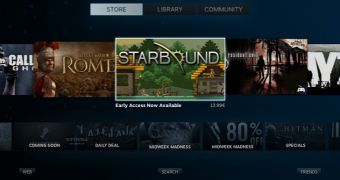SteamOS, the operating system developed by Valve and based on Debian, has undergone a lot of changes in order to become the ultimate gaming Linux platform, and now its makers are also considering to change its genesis.
Up until a day or so ago, Valve was saying that SteamOS was a Linux distribution based on Debian, but so much work has been done to the operating system that it chose to further refine its genesis, in accordance to the rules used by the open source community.
“SteamOS is a fork (derivative) of Debian[www.debian.org] GNU/Linux. The first version (SteamOS 1.0) is called ‘alchemist’ and it is based on the Debian ‘wheezy’ (stable 7.1) distribution,” now reads the official FAQ for this OS. This doesn't really change anything with SteamOS, but it establishes that Valve's SteamOS is going in a different direction.
Operating systems based on another OS, like Ubuntu, for example, don't call themselves Debian forks. When something major changes in the base distro, all the other systems that are based on the OS usually make the same turn. Ubuntu for example chose Systemd because Debian did it.
Forks, on the other hand, even if the new Linux distribution relies on the original operating system for various components, like the repositories, will not stay on the same path and usually tend to do things a little differently.
For example, SteamOS comes with a custom graphics compositor designed to provide a seamless transition between Steam, its games, and the SteamOS system overlay. This doesn't break any dependencies with the upstream Debian, but the new system uses a component that is radically different from the source.
The hardware system requirements have remained largely the same since the launch, with a few modifications: Intel or AMD 64-bit capable processor, 4GB or more memory, a 250GB or larger disk, NVIDIA, Intel, or AMD graphics card, and a USB port or a DVD drive for installation.
Fortunately, the operating system now supports dual-boot, which has been integrated due to the pressure from the community, which was already building an alternative SteamOS version that was doing better than the original.
Valve updates the operating system very often, and users can tell that SteamOS is just in its infancy. Making the new SteamOS a fork of Debian is another way of the Valve developers of saying that major changes are coming and that the new Linux distribution will someday look and feel a lot different than Debian.

 14 DAY TRIAL //
14 DAY TRIAL //